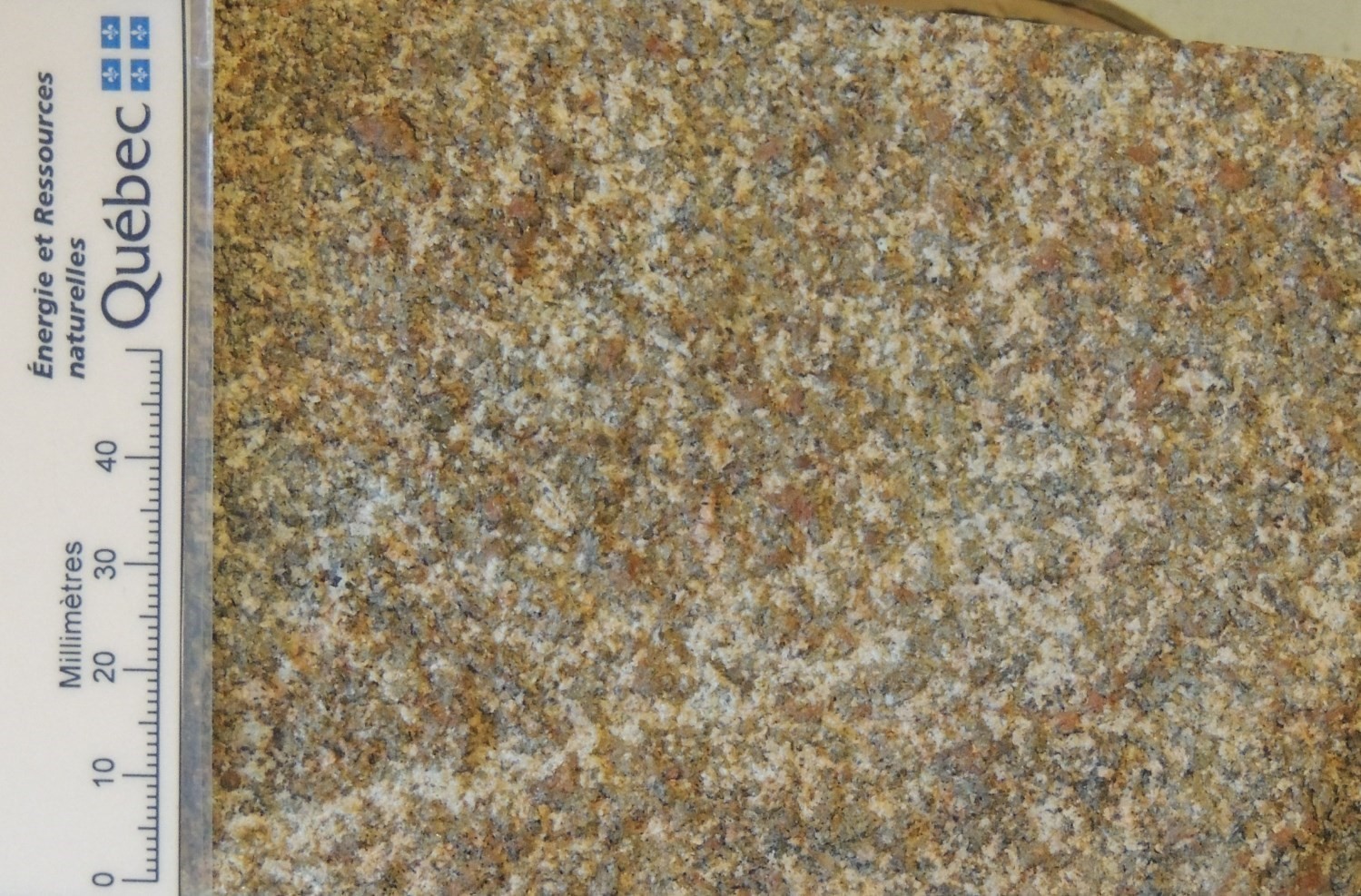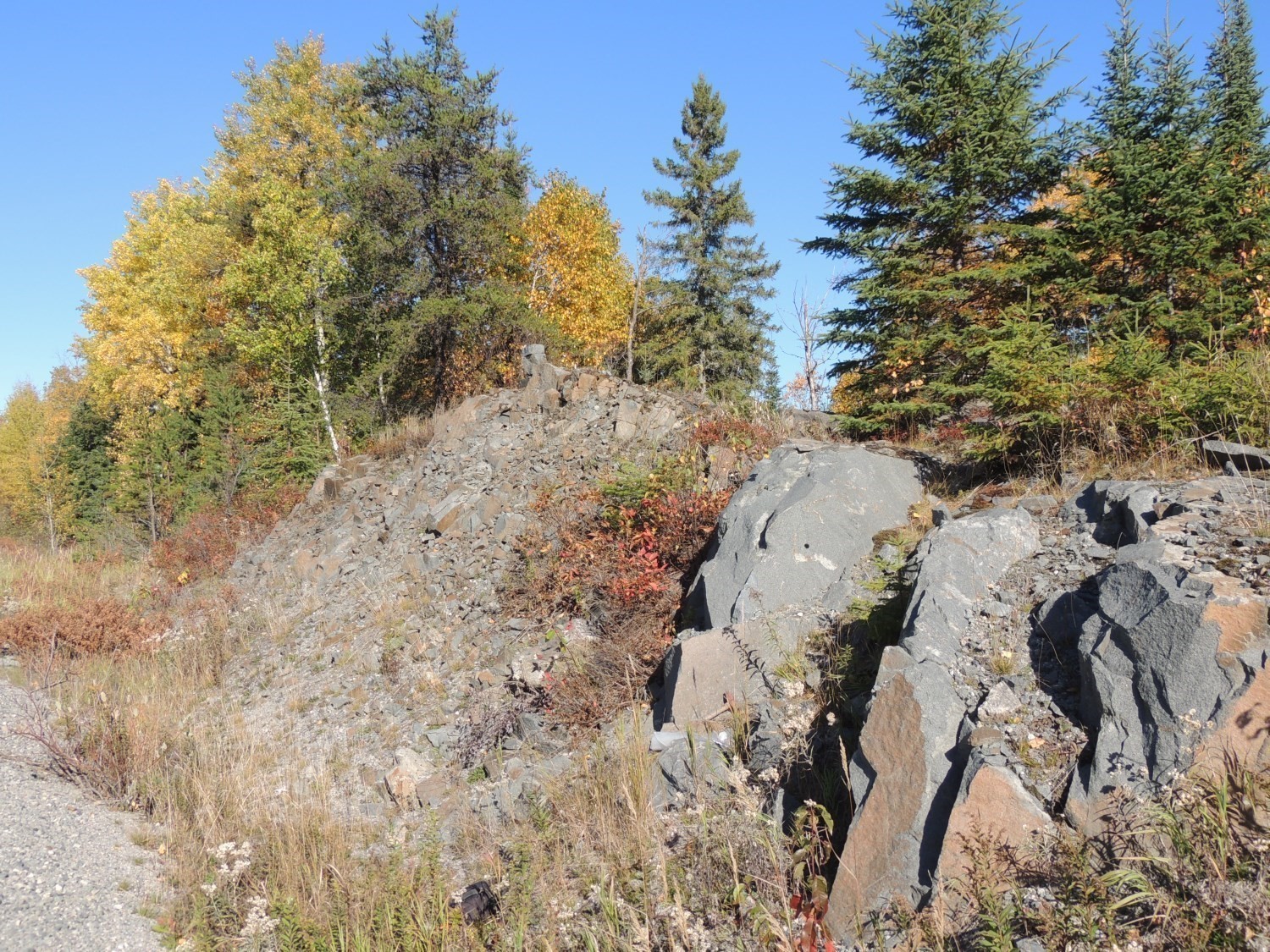
Last modified: 8 November 2019
Translation of original French
| Author: | Buchan et al., 1993 |
| Age: | Paleoproterozoic |
| Reference section: | None |
| Type area: | Southeastern part of the Superior Province, including the Abitibi Subprovince in Quebec and NE Ontario, as well as in the James Bay area |
| Geological province: | Superior Province |
| Geological subdivision: | Pontiac, Abitibi (and Wawa, Ontario), La Grande, Opatica, Opinaca, Nemiscau, Ashuanipi and Minto subprovinces |
| Lithology: | Diabase of gabbronoritic composition |
| Type: | Lithodemic |
| Rank: | Suite |
| Status: | Formal |
| Use: | Active |
- None
-
Background
Post-Archaean dykes and diabase sills have been known since the beginning of geological mapping of the Canadian Shield of Quebec and Ontario (e.g. Murray et al., 1897). L’Espérance (1948) and Gill and L’Espérance (1952) noted that these dykes were most likely of Keweenawian (Mesoproterozoic) age and could be divided into three categories: 1) undifferentiated or ordinary diabase; 2) quartz diabase; and 3) olivine diabase. Moore (1929) concluded that olivine diabases were consistently younger than quartz diabases.
The map of Fahrig and West (1986), based on compilation and interpretation of aeromagnetic surveys, illustrates the distribution of diabase dyke swarms in the Canadian Shield, as well as their chronology based on isotopic ages. On this map, NE dykes of western Quebec are associated with the Preissac Swarm. Later, the paleomagnetism and geochronology work of Buchan et al. (1993) divided these dykes into two groups: the Senneterre Dykes and the Biscotasing Dykes.
The S6 dyke of Buchan et al. (1993) is the reference dyke and cuts Archean rocks in the Senneterre region of Quebec. It is outcropping (2016-JG-2859) along Route 113, 300 m south of the entrance to Lafontaine Road (sheet 32C03, UTM NAD 1983, Zone 18, 324308 mE, 5337948 mN). This outcrop corresponds to Site 30 sampled by Buchan et al. (1993) during their paleomagnetic and geochronological study. U-Pb isotopic dating yielded Paleoproterozoic age for these dykes. In 2016, a sample was taken from this site for geochemistry (analysis 2016067640).
Description
The Senneterre diabase Dykes are traced from outcrops and the magnetic field vertical gradient map. They have a straight signature over kilometers with a NE to ENE orientation.

 Their contact with surrounding rocks is sharp. Their thickness varies from a few meters to 120 m. Diabase has a brown patina and a green fresh exposure. A centimeter-thick aphanitic chill margin is commonly observed. The dykes’ center is typically medium-grained. The rock is massive, homogeneous and slightly deformed. Fracture networks are typically perpendicular to dyke orientation.
Their contact with surrounding rocks is sharp. Their thickness varies from a few meters to 120 m. Diabase has a brown patina and a green fresh exposure. A centimeter-thick aphanitic chill margin is commonly observed. The dykes’ center is typically medium-grained. The rock is massive, homogeneous and slightly deformed. Fracture networks are typically perpendicular to dyke orientation.
 Petrographic description is based on thin section observations from NTS sheets 33F, 33G and 33H. Medium-grained dykes are composed of plagioclase, augite and orthopyroxene, which form an intersertal or intergranular, and rarely equigranular, microstructure. Ophitic and subophitic structures have not been observed since pyroxene crystals are typically smaller or the same size as plagioclase. Pseudomorphs of olivine and orthopyroxene automorphic phenocrysts (0.5 to 1 mm) were observed in thin sections in the chilled margin of some dykes. Magnetite-ilmenite is scarce (1 to 3%, 0.5 to 1 mm). Quartz is generally absent, but traces are observed in thin sections (<1%, <0.5 mm) of some dykes and up to 3% (0.2 to 0.5 mm) in one of the Senneterre Dykes spanning sheets 33H03 and 33H07. Traces of apatite, biotite, usually chloritized (0.5 to 1 mm) and pyrite are also noted. The level of uralization and sericitization varies from medium to high. Orthopyroxene is usually altered (chlorite, amphibole, serpentine) and therefore more difficult to recognize in thin sections. Epidote and carbonate are also observed in several thin sections.
Petrographic description is based on thin section observations from NTS sheets 33F, 33G and 33H. Medium-grained dykes are composed of plagioclase, augite and orthopyroxene, which form an intersertal or intergranular, and rarely equigranular, microstructure. Ophitic and subophitic structures have not been observed since pyroxene crystals are typically smaller or the same size as plagioclase. Pseudomorphs of olivine and orthopyroxene automorphic phenocrysts (0.5 to 1 mm) were observed in thin sections in the chilled margin of some dykes. Magnetite-ilmenite is scarce (1 to 3%, 0.5 to 1 mm). Quartz is generally absent, but traces are observed in thin sections (<1%, <0.5 mm) of some dykes and up to 3% (0.2 to 0.5 mm) in one of the Senneterre Dykes spanning sheets 33H03 and 33H07. Traces of apatite, biotite, usually chloritized (0.5 to 1 mm) and pyrite are also noted. The level of uralization and sericitization varies from medium to high. Orthopyroxene is usually altered (chlorite, amphibole, serpentine) and therefore more difficult to recognize in thin sections. Epidote and carbonate are also observed in several thin sections.
Thickness and distribution
The thickness of the Senneterre Dykes varies from a few meters to more than 120 m. They generally extend over a few tens to a few hundred kilometers. Their dip is subvertical.
The Senneterre Dykes covers an area of 240,000 km2. They are relatively spaced contrary to the Mistassini, Matachewan or Biscotasing dykes. For example, in the La Grande and Eastmain rivers area (James Bay), the distance between dykes ranges from 40 to 100 km. According to Buchan et al. (2007) and Hamilton and Buchan (2016), these dykes would be radial to a focus located west of the Labrador Trough. They intersect Archean rocks of the Superior Province, as well as Paleoproterozoic clastic rocks of the Sakami Formation in the La Grande 3 reservoir region (Goutier et al., 2001).
Dating
The age of the Senneterre Dykes ranges from 2221 ±4 Ma to 2216 +8/-4 Ma. Their emplacement is contemporaneous with that of the Nipissing gabbroic sills of Ontario (2219 Ma to 2210 Ma, Corfu and Andrews, 1986; Krogh et al., 1987; Noble and Lightfoot, 1992), as well as dykes from the Klotz and Maguire swarms (Maurice et al., 2009).
| Unit | Sample Number | Isotopic System | Mineral | Cristallization Age (Ma) | (+) | (-) | Reference(s) |
| pPsen | Senneterre dyke | U-Pb | Baddeleyite | 2214.3 | 12.4 | 12.4 | Buchan et al., 1993 |
| – | U-Pb | Baddeleyite | 2216 | 8 | 4 | Mortensen, unpublished data, in Buchan et al., 1996 | |
| 2011-GM-5283A | U-Pb | Baddeleyite | 2221 | 4 | 4 | Davis et al., 2018 |
Stratigraphic Relationship(s)
The Senneterre Dykes cut Archean rocks of the Superior Province, as well as Paleoproterozoic clastic rocks of the Sakami Formation in the La Grande 3 reservoir region (Goutier et al., 2001). They are rarely associated with shear zones or major regional faults.
Paleontology
Does not apply.
References
| Author(s) | Title | Year of publication | Hyperlink (EXAMINE or Other) |
|---|---|---|---|
| BUCHAN, K.L. – MORTENSEN, J.K. – CARD, K.D. | Northeast-trending Early Proterozoic dykes of the southern Superior Province: multiple episodes of emplacement recognized from integrated paleomagnetism and U-Pb geochronology. Canadian Journal of Earth Sciences; volume 30, pages 1286-1296. | 1993 | Source |
| BUCHAN, K.L. – HALLS, H.C. – MORTENSEN, J.K. | Paleomagnetism, U-Pb geochronology and geochemistry of Marathon dykes, Superior Province, and comparison with the Fort Frances swarm. Canadian Journal of Earth Sciences; volume 33, pages 1583-1595. | 1996 | Source |
| BUCHAN, K.L. – ERNST, R.E. | Essaims de dykes de diabase et unités apparentés au Canada et dans les régions avoisinantes. Commission géologique du Canada; carte 2022A, échelle 1/5 000 000. | 2004 | Carte 2022A |
| BUCHAN, K.L.– GOUTIER, J. HAMILTION, A.– ERNST, R.E. – MATTHEWS, W.A. | Paleomagnetism, U-Pb geochronology and geochemestry of Lac Esprit area, Quebec, and implication for Paleoproterozoic deformation of the Superior Province, Québec, Canada. Canadian Journal of Earth Sciences; volume 44, pages 643-664. | 2007 | Source |
| CORFU, F. – ANDREW, A.J. | A U-Pb age for mineralized Nipissing diabase, Gowganda. Ontario. Canadian Journal of Earth Sciences; volume 23, pages 107-189. | 1986 | Source |
| DAVIS, D.W. – LAFRANCE, I. – GOUTIER, J. – TALLA TAKAM, F. – BANDYAYERA, D. – GIGON, J. | Datations U-Pb dans les provinces de Churchill et du Supérieur effectuées au JSGL en 2013-2014. Ministère de l’Énergie et des Ressources naturelles, Québec; RP 2017-01, 63 pages. | 2018 | RP 2017-01 |
| FAHRIG, W.F. – WEST, T.D. | Diabase dykes swarms of the Canadian Shield – Essaims de dykes diabasiques du Bouclier canadien. Commission géologique du Canada; carte 1627A. | 1986 | Source |
| GILL, J.E. – L’ESPÉRANCE, R. | Diabase Dykes in the Canadian Shield. Transactions of the Royal Society of Canada; volume XLVI, series III, section four, pages 25-36. | 1952 | – |
| GOUTIER, J. – DION, C. – OUELLET, M.-C. – MERCIER-LANGEVIN, P. – DAVIS, D.W | Géologie de la colline Masson, de la passe Awapakamich, de la baie Carbillet et de la passe Pikwahipanan (33F/09, 33F/10, 33F/15 et 33F/16). Ministère des Ressources naturelles, Québec; RG 2000-10, 69 pages, 4 plans. | 2001 | RG 2000-10 |
| HAMILTON, M.A. – BUCHAN, K.L. | A 2169 Ma U–Pb baddeleyite age for the Otish Gabbro, Quebec: implications for correlation of Proterozoic magmatic events and sedimentary sequences in the eastern Superior Province. Canadian Journal of Earth Sciences, volume 53, pages 119-128. | 2016 | Source |
| KROGH, T.E. – CORFU, F. – DAVIS, D.W. – DUNNING, G.R. – HEAMAN, L.M. – KAMO, S.L. – MACHADO, N. – GREENOUGH, J.D. – NAKAMURA, E. | Precise U-Pb isotopic ages of diabase dykes and mafic to ultramafic rocks using trace amounts of baddeleyite and zircon. In: Mafic dyke swarms (Halls H.C. and Fahrig W.F., eds). Geological Association of Canada; Special Paper 34, pages 147-152. | 1987 | – |
| L’ESPÉRANCE, R.L. | A study of the diabase dykes of the Canadian Shield. McGill University; master thesis, 48 pages, 1 carte. | 1948 | – |
| MAURICE, C. – DAVID, J. – O’NEIL, J. – FRANCIS, D. | Age and tectonic implications of Paleoproterozoic mafic dyke swarms for the origin of 2.2 Ga enriched lithosphere beneath the Ungava Peninsula, Canada. Precambrian Research; volume 174, pages 163-180. | 2009 | Source |
| MOORE, E.S. | Keweenawan Olivine Diabase of the Canadian Shield. Transactions of the Royal Society of Canada; section IV, pages 39-45. | 1929 | – |
| MURRAY, A – BELL, R. – BARLOW, A.E. | Province of Ontario, Nipissing, Algoma and Parry Sound districts, French River sheet. Geological Survey of Canada; map 570. | 1897 | Source |
| NOBLE, S.R. – LIGHTFOOT, P.C. | U-Pb baddeleyite ages of the Kerns and Triangle Mountain intrusions, Nipissing Diabase, Ontario. Canadian Journal of Earth Sciences; volume 29, pages 1424-1429. | 1992 | Source |

